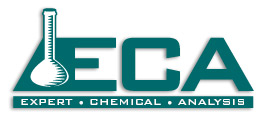Thin Layer Chromatography/TLC
Thin-Layer Chromatography
ECA has extensive experience using thin-layer chromatography (TLC) as an analytical technique for qualitative and quantitative chemical analysis. TLC can be used in the following circumstances:
1. Determination of unknown compounds in a mixture using a reference standard.
2. Determination of impurities in a sample.
3. Determination of the number of uniquely different compounds in a mixture.
4. Monitoring the progress of organic reactions.
TLC is a very powerful technique for some compounds that have very few analytical methods that can be used in their analysis.
The basis of the standard TLC technique is given below:
1. The sample is applied to a glass or metal plate coated with silica gel.
2. The plate is placed in a tank partially filled with a solvent mixture specially chosen to separate the various components. (if unknowns are being analyzed, a general mixture is used)
3. The compounds in the sample are separated relative to their affinity for either the solvent mixture or the silica gel. More affinity for silica causes a slower elution, while more affinity for the solvent mixture promotes a faster elution.
4. After separation, the plate is removed from the solvent mixture and the separated compounds are detected using a number of specific and nonspecific detection means.
We have used TLC to quantify sebum lipids in skin patch samples using TLC separation and densitometry to quantify the various skin lipids. TLC is especially useful for compounds that have no chromophores and/or polymeric samples as these are generally less amenable to other chromatography methods.
ECA also employs a Chromatotron which is a centrifugal TLC device that can rapidly separate large amounts of mixtures to provide fractions that can then be weighed to determine amount and then can be analyzed using FTIR to determine identity.
Please give us a call if you have the need to run TLC analysis.
